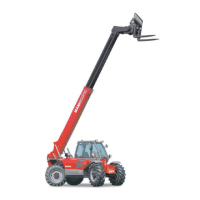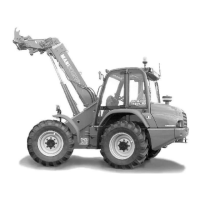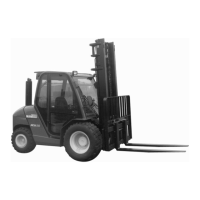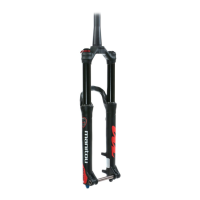1-10
1-10
E - STARTING THE LIFT TRUCKE - STARTING THE LIFT TRUCK
SAFETY INSTRUCTIONSSAFETY INSTRUCTIONS
The lift truck must only The lift truck must only be started up or be started up or maneuvered when the operator is sitting in the driver’s cab, with maneuvered when the operator is sitting in the driver’s cab, with his seat belt adjusted and fastened.his seat belt adjusted and fastened.
-- Never try to starNever try to star t the lift truck by pushing or towing it. St the lift truck by pushing or towing it. Such operation may cause such operation may cause severe damage to the transmission. evere damage to the transmission. If necessary,If necessary,
to tow the lift truck in an emergency, the transmission must be placed in the neutral position (see: 3 - MAINTENANCE: G -to tow the lift truck in an emergency, the transmission must be placed in the neutral position (see: 3 - MAINTENANCE: G -
OCCASIONAL MAINTENANCE).OCCASIONAL MAINTENANCE).
-- If using an emergency batteIf using an emergency batterry for start-up, use a battery with the same chy for start-up, use a battery with the same characteristics and respect aracteristics and respect battery polarity when connectingbattery polarity when connecting
it. Connect at first the positive terminals before the negative terminals.it. Connect at first the positive terminals before the negative terminals.
Failure to respect polarity between batteries can cause serious damage to the electrical circuit. The electrolyte in Failure to respect polarity between batteries can cause serious damage to the electrical circuit. The electrolyte in the battery may produce an the battery may produce an explosiveexplosive
gas. Agas. Avoid flames and void flames and generation of generation of sparks clossparks close to the bate to the batteries. Never disteries. Never disconnect a bconnect a battery while it is chattery while it is charging.arging.
INSTRUCTIONSINSTRUCTIONS
- Check the closing and locking - Check the closing and locking of the hood(s).of the hood(s).
- Check that the cab door is - Check that the cab door is closed.closed.
- Check that the forward/reverse selector is in neutral.- Check that the forward/reverse selector is in neutral.
- Turn the ignition key to - Turn the ignition key to the position I to activate the the position I to activate the electrical system and the preheat.electrical system and the preheat.
-- Whenever you switch on the lift Whenever you switch on the lift truck, pertruck, perform the automatic check on the longitudinal staform the automatic check on the longitudinal stability alarm system (see: 2 - DESCRbility alarm system (see: 2 - DESCRIPTION:IPTION:
INSTRUMENTS AND CONTROLS). Do not use the lift truck if it does not conform to the regulations.INSTRUMENTS AND CONTROLS). Do not use the lift truck if it does not conform to the regulations.
-- Check the fuel Check the fuel level on the indicatorlevel on the indicator..
-- Turn the ignition key fully: tTurn the ignition key fully: the I.C. engine should then he I.C. engine should then start. Release the ignition key and let the I.C. start. Release the ignition key and let the I.C. engine run at idle.engine run at idle.
-- Do not engage the starter motor for more than 15 secondDo not engage the starter motor for more than 15 seconds and carrs and carry out the preheating between unsuy out the preheating between unsuccessful attempts.ccessful attempts.
- Make sure all the signal lights on the control instrument panel are off.- Make sure all the signal lights on the control instrument panel are off.
-- Check all control instruments when the I.Check all control instruments when the I.C. engine is warm and at regular inteC. engine is warm and at regular interrvals during use, so vals during use, so as to quickly detect as to quickly detect any faultsany faults
and to be able to and to be able to correct them without any correct them without any delay.delay.
-- If an instrument does not show thIf an instrument does not show the correct display, ste correct display, stop the I.C. engine and op the I.C. engine and immediately carrimmediately carry out the necessary operations.y out the necessary operations.
F - DRIVING THE LIFT TRUCKF - DRIVING THE LIFT TRUCK
SAFETY INSTRUCTIONSSAFETY INSTRUCTIONS
Operators’ attention is drawn to the risks involved in using the Operators’ attention is drawn to the risks involved in using the lift truck, in parlift truck, in particular:ticular:
- - Risk Risk of of losing losing control.control.
- - Risk Risk of of losing losing lateral lateral and and frontal frontal stability stability of of the the lift lift truck.truck.
The operator must remain in control of the The operator must remain in control of the lift truck.lift truck.
In the event of the lift truck overturning, do not try to leave the cabin during the incident. YOUR BEST PROTECTION IS TO STAY FASTENED IN THE CABIN.In the event of the lift truck overturning, do not try to leave the cabin during the incident. YOUR BEST PROTECTION IS TO STAY FASTENED IN THE CABIN.
- Observe the company’s traffic regulations or, by default, the public highway code.- Observe the company’s traffic regulations or, by default, the public highway code.
- Do not carry out operations which exceed the capacities of your lift truck or attachments.- Do not carry out operations which exceed the capacities of your lift truck or attachments.
-- Always drive the lift truck with the forks Always drive the lift truck with the forks or attachment to the tor attachment to the transport position, i.e. at 300ransport position, i.e. at 300 mm from the ground, the jib mm from the ground, the jib retractedretracted
and the carriage sloping backwards.and the carriage sloping backwards.
- Only carry loads which are balanced and properly anchored to avoid any risk of a load falling off.- Only carry loads which are balanced and properly anchored to avoid any risk of a load falling off.
- Ensure that palettes, cases, etc, are in - Ensure that palettes, cases, etc, are in good order and suitable for good order and suitable for the load to be lifted.the load to be lifted.
- Familiarise yourself with the lift truck on the terrain where it will be used.- Familiarise yourself with the lift truck on the terrain where it will be used.
- Ensure that the service brakes are working properly.- Ensure that the service brakes are working properly.
- The loaded lift truck must not travel at - The loaded lift truck must not travel at speeds in excess of speeds in excess of 1212 km/h.km/h.
-- Drive smoothly at an appropriate speeDrive smoothly at an appropriate speed for the operating conditions (d for the operating conditions (land configuration, load on the lift land configuration, load on the lift truck).truck).
- Do not use the hydraulic jib controls when the lift truck is moving.- Do not use the hydraulic jib controls when the lift truck is moving.
-- Do not manoeuvre the lift truck with the jib in Do not manoeuvre the lift truck with the jib in the raised position unless the raised position unless under exceptional circumstances and tunder exceptional circumstances and then with extremehen with extreme
caution, at very low speed and using gentle braking. Ensure that visibility is adequate.caution, at very low speed and using gentle braking. Ensure that visibility is adequate.
- Take bends slowly.- Take bends slowly.
- In all circumstances make sure you are in control of your speed.- In all circumstances make sure you are in control of your speed.
- On damp, slippery or uneven terrain, drive slowly.- On damp, slippery or uneven terrain, drive slowly.
- Brake gently, never abruptly.- Brake gently, never abruptly.
- Only use the lift truck’s forward/reverse selector from a stationary position and never do so abruptly.- Only use the lift truck’s forward/reverse selector from a stationary position and never do so abruptly.
- Do not drive with your foot on the brake pedal.- Do not drive with your foot on the brake pedal.
-- Always remember that hydrostatic type Always remember that hydrostatic type steering is extremely sensitive to movement steering is extremely sensitive to movement of the steering wheel, sof the steering wheel, so turn it gently ando turn it gently and
not jerkily.not jerkily.
- Never leave the I.C. engine on when the lift truck is unattended.- Never leave the I.C. engine on when the lift truck is unattended.
- Do not leave the cab when the lift truck has a raised load.- Do not leave the cab when the lift truck has a raised load.
- Look where you are going and always make sure you have good visibility along the route.- Look where you are going and always make sure you have good visibility along the route.

